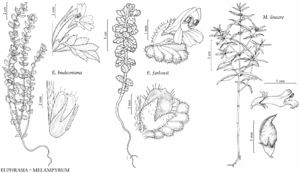Melampyrum
Sp. Pl. 2: 605. 1753.
| Taxon | Illustrator ⠉ | |
|---|---|---|
 | Euphrasia hudsoniana Euphrasia farlowii Melampyrum lineare | Barbara Alongi Barbara Alongi Yevonn Wilson-Ramsey |
Herbs, annual; hemiparasitic. Stems erect, not fleshy, puberulent. Leaves cauline, moreorless decussate; petiole absent or minute; blade not fleshy, not leathery, margins entire, sometimes margins of distal leaves proximally toothed. Inflorescences axillary, flowers 2 per axil; bracts present. Pedicels absent or minute; bracteoles absent. Flowers: sepals 4, calyx bilaterally symmetric, campanulate, lobes subulate; petals 5, corolla white, sometimes tinged with pink, strongly bilabiate, scarcely curved, abaxial lobes 3, adaxial 2, adaxial lip galeate; stamens 4, didynamous, filaments glabrous; staminode 0; ovary 2-locular, placentation axile; stigma moreorless capitate. Capsules: dehiscence loculicidal. Seeds 1–4, tan drying black, ellipsoid, wings absent. x = 9.
Distribution
North America, Eurasia
Discussion
Species 20–35 (1 in the flora).
Melampyrum occupies a broad range of habitats and infects a taxonomically and ecologically diverse range of hosts. No recent comprehensive taxonomic treatment of Melampyrum exists. Species number estimates range from 20 (K. J. Kim and S. M. Yun 2012) to 35 (E. Fischer 2004). A molecular phylogenetic study of the Rhinantheae (in the sense of Fisher) supports the monophyly of Melampyrum, placing it sister to the remaining Rhinantheae (J. Těšitel et al. 2010). Melampyrum is unusual in Orobanchaceae in that the seeds are relatively large and few per capsule. The seeds bear an elaiosome that has been linked to dispersal by ants (W. Gibson 1993).
Selected References
None.